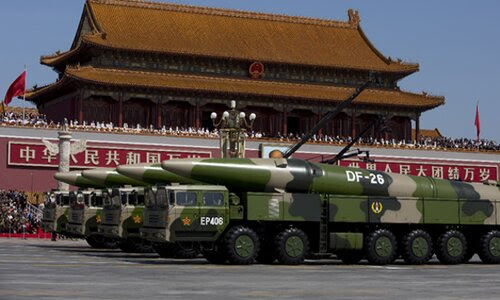
What Happens In Washington Next Week Could Reshape Israel & The Middle East
The Middle East is once again approaching a critical turning point. Behind diplomatic smiles and bold headlines lies a complex and dangerous question–one that has echoed since the birth of modern Israel: Will Israel be forced to give up land for peace yet again? That is the heart of the matter.
The Middle East is once again approaching a critical turning point. Behind diplomatic smiles and bold headlines lies a complex and dangerous question–one that has echoed since the birth of modern Israel: Will Israel be forced to give up land for peace yet again? That is the heart of the matter.
Prime Minister Benjamin Netanyahu is heading to Washington on Monday along with Strategic Affairs Minister Ron Dermer. The Israeli cabinet, according to reports, will wait to hear back from Dermer’s discussions before deciding on next steps in Gaza.
The urgency of these talks escalated on Sunday when President Donald Trump posted to Truth Social, calling for a deal to “get the hostages back!!!” That message, paired with whispers of a massive regional realignment, raises critical questions: Is a Gaza deal–centered on the hostages–being quietly tied to an expanded Abraham Accords? And if so, what price will Israel be expected to pay?
Behind the Curtain of “Peace”
The Abraham Accords marked a powerful diplomatic shift in 2020, normalizing relations between Israel and several Arab nations. Now, a second wave appears to be forming–possibly with Saudi Arabia and shockingly, Syria, among the participants.
To grease the wheels, Donald Trump has moved to lift all sanctions on Syria, signaling a potential thaw between Israel and the new Syrian regime. That is stunning on its face, considering Syria’s long-standing alignment with Iran and Hezbollah.
But peace agreements in the Middle East rarely come free. And this time, the price may not just be diplomatic recognition. It could involve territorial concessions, hostage deals, and a radically reimagined future for Gaza.
Gaza, the Hostages, and the Bigger Deal
Inside the current negotiations is a potential framework being floated: Arab nations–perhaps Egypt, Jordan, or even Saudi Arabia–could temporarily take over governance or security responsibilities in Gaza following a ceasefire and the return of Israeli hostages. This arrangement would help sideline Hamas while maintaining Arab control in the eyes of the region. In exchange, Israel would scale down military operations and exit from the Gaza strip.
This sounds appealing to international diplomats–but that is unlikely to be enough.
Will Israel be pressured to agree to a deal that leaves Hamas intact in any form, even by proxy? Will global powers use the return of Israeli hostages as leverage to push broader territorial concessions in Gaza, Judea, or even the Golan Heights?
Syria’s Shocking Role–and the Golan in the Crosshairs?
As part of the broader push for normalization, Syria is now being discussed as a potential participant in the Abraham Accords. But Syria comes with baggage–and territory. With international pressure mounting to bring Syria back into the fold, Israel may be quietly asked to give up what it has secured after Assad’s collapse.
That includes strategic positions near Mount Hermon, seized to protect Israeli citizens from Iranian proxies and jihadist terror cells operating separate from the new Syrian government.
Justice Minister Gideon Sa’ar reaffirmed that Israel applied its law to the Golan Heights over 40 years ago, making it sovereign Israeli territory. But that hasn’t stopped global voices from suggesting that the Golan–or parts of it–could be used as a bargaining chip.
The Two-State Mirage and Saudi Arabia’s Old Demands
There are other pieces to the puzzle. For years, Saudi Arabia has floated normalization in exchange for impossible demands: a Palestinian state, the division of Jerusalem, and a freeze on settlement growth in Judea and Samaria.
After the horrors of October 7th–when Hamas slaughtered over 1,200 Israeli civilians–Israel’s population has overwhelmingly rejected the idea of a Palestinian state. The trauma of Gaza’s past was made horrifyingly clear: land for peace leads to terror, not coexistence.
Yet, as talks unfold, there’s growing concern that a new Gaza governance plan–whether via Arab states or international coalitions–may become a backdoor path to Palestinian statehood. If Israel halts its military efforts and permits external actors to step in, the world will label it “progress.” But in reality, it may become the first brick in a rebuilt road toward dividing the land once again.
The Temple Mount Awakens: Is The Third Temple Closer Than We Think?

Something is stirring in Jerusalem – and it’s not just politics. With Iran on the back foot, Hamas and Hezbollah scattered, and the winds of Middle East diplomacy blowing once again, a different kind of conversation is quietly picking up steam: Could we be approaching the day when the Jewish Temple is rebuilt?
Something is stirring in Jerusalem—and it’s not just politics. With Iran on the back foot, Hamas and Hezbollah scattered, and the winds of Middle East diplomacy blowing once again, a different kind of conversation is quietly picking up steam: Could we be approaching the day when the Jewish Temple is rebuilt?
For many Jews, this is more than wishful thinking. It’s a sacred hope deeply rooted in thousands of years of Scripture and tradition. Since the harrowing attacks of October 7, a religious revival has taken root across Israel, especially among younger generations. Jewish identity is being reawakened—not just as a cultural or national label, but as a spiritual calling. And at the center of that calling lies the Temple Mount, the holiest site in Judaism, and the long-awaited Third Temple.
While most global observers remain focused on ceasefire negotiations and regional security, something even more significant may be quietly unfolding. For those with eyes to see, a series of developments suggest that the ground is being spiritually—and quite literally—prepared for the rebuilding of the Temple in Jerusalem. Whether it will be rebuilt by political action, divine intervention, or some mysterious blend of both remains to be seen. But the preparations are no longer theoretical. They are real, visible, and accelerating.
Why Do Jews Want the Temple Rebuilt?
To understand the gravity of this moment, Christians must first understand what the Temple means to the Jewish people. The First Temple, built by Solomon in the 10th century BC, was the dwelling place of God on earth. It housed the Ark of the Covenant and served as the spiritual and national center of Jewish life until its destruction by the Babylonians in 586 BC.
The Second Temple, built after the Babylonian exile, stood for nearly 600 years before being destroyed by the Romans in 70 AD. Since then, Jews have mourned the loss of their Temple daily. Its absence is not just historical—it’s personal and theological. The Temple is where heaven touched earth. Without it, the full expression of Jewish worship is incomplete.
Rebuilding the Temple is not about nationalism or conquest for religious Jews—it’s about redemption, restoration, and relationship with God. For millennia, Jewish prayers have included the words: “May it be Your will that the Temple be rebuilt speedily in our days.” Today, many Jews believe those days may finally be upon us.
Signs of Preparation: Red Heifers, Temple Vessels, and Training Programs
Incredibly, actual preparations for a rebuilt Temple are already underway. Five red heifers—pure, unblemished animals required by biblical law for purification rites—have been brought to Israel from Texas. If any remain eligible after close rabbinical inspection, they could be used in the ritual purification of priests and Temple vessels, a requirement for resuming Temple service (Numbers 19).
Meanwhile, the Temple Institute in Jerusalem has spent decades reconstructing all the vessels, garments, and instruments needed for Temple worship—from the golden menorah to the High Priest’s breastplate. These are not museum replicas—they are intended for real use.
And now, the most striking development yet: actual training programs for future priests (kohanim) are in full swing.
The ultra-Orthodox Toldos Aharon movement—long known for its opposition to the modern State of Israel—has begun training kohanim for Temple service. Yes, you read that right: a group that rejects Zionism is preparing for the Temple to be rebuilt in Jerusalem. Why? Because they believe the Messiah is near and the Temple will be divinely restored, not politically constructed. Their Rebbe has stated plainly: “We clearly see we are at the footsteps of the Messiah.”
Their kollel (study program) runs daily from 4:40 to 7:00 a.m., training priests in the laws of ritual service. It’s a stunning paradox—anti-Zionist Jews preparing to serve in a Temple that sits at the heart of the modern Israeli capital.
Even more remarkable: science appears to confirm the ancient lineage of the kohanim. Over 98% of men who claim priestly descent share a distinct genetic marker—evidence that their bloodline has been preserved for over 3,000 years.
Wheat for Offerings and Songs on the Mount
Other developments are equally symbolic. The Israeli milling company Shtibel has announced it will begin producing flour suitable for Temple offerings, using a special dry milling process to meet ancient purity laws. Producing even a small amount of kosher semolina requires hundreds of pounds of carefully cultivated Israeli wheat, processed without any moisture. It’s not profitable—but it is prophetic. “This is about more than economics,” said the company’s head of R&D. “It’s about belonging and destiny.”
Meanwhile, Jews are doing something on the Temple Mount that has been forbidden for decades: singing.
Signs of the Times
Robocop In The Pulpit: When Pastors Turn Justice Into A Joke

In a world crying out for truth, righteousness, and spiritual clarity, it is nothing short of tragic when those entrusted with proclaiming the gospel instead descend into absurdity and blasphemy.
When Wolves Preach And The Sheep Applaud: The Tragic Apostasy Of The ELC

There was a time when heresy had to knock to get inside the church. Now, it holds the microphone at Evangelical Lutheran Churches across the country.
Gog and Magog Update
China’s Rapid Nuclear Push: Much More Than A Deterrent

The People’s Republic of China is not simply building up its military-it is unleashing a nuclear revolution. No longer satisfied with a modest deterrent, China is now racing toward nuclear parity, and eventually supremacy, over the United States.
Ahead of Israeli Prime Minister Benjamin Netanyahu’s visit to the White House next week, US President Donald Trump said that he will take a “firm stance” with the premier about ending the war in Gaza.

Speaking to reporters while touring a migrant detention center in Florida, Trump said he hopes to end the 21-month conflict “sometime next week.”
Last week, the president predicted that a hostage release and ceasefire deal would be reached this week.
Trump also told reporters that Netanyahu “wants to end the war.”
On Sunday, Trump put forward a proposal that would liberate all of the captives and send Hamas leaders into exile. “We’re confident a deal can be reached,” a US official told The Jerusalem Post.